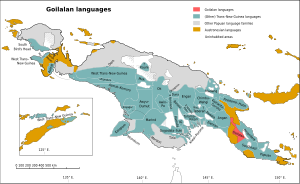| Goilalan | |
|---|---|
| Wharton Range | |
| Geographic distribution | Wharton Range, Central Province, Papua New Guinea |
| Linguistic classification | Binanderean–Goilalan
|
| Language codes | |
 Map: The Goilalan languages of New Guinea
The Goilalan languages
Trans–New Guinea languages
Other Papuan languages
Austronesian languages
Uninhabited Map: The Goilalan languages of New Guinea
The Goilalan languages
Trans–New Guinea languages
Other Papuan languages
Austronesian languages
Uninhabited | |
The Goilalan or Wharton Range languages are a language family spoken around the Wharton Range in the "Bird's Tail" of New Guinea. They were classified as a branch of the Trans–New Guinea languages by Stephen Wurm (1975), but only tentatively retained there in the classification of Malcolm Ross (2005) and removed entirely by Timothy Usher (2020).
Languages
The languages are,
The languages are clearly related, especially northern Biagai, Kunimaipa, and Weri, which might be considered divergent dialects.
Pronouns
Pronouns are:
Tauade also has the possessive pronouns ne-ve, ni-e.
Vocabulary comparison
The following basic vocabulary words are from SIL field notes (1973, 1975, 1980), as cited in the Trans-New Guinea database.
The words cited constitute translation equivalents, whether they are cognate (e.g. ʒuvalo, kupal'iai for “two”) or not (e.g. gadolo, kepapaí for “ear”). Notice the very low number of cognate pairs.
gloss Fuyug Tauade head hul ha; ondobe kɔrɔtɔ hair are; hul haluma awutu ear gadolo kepapaí eye hul li; im tavai nose hul hunga; unge kiːtʰ tooth hul usi nɔtɔvai tongue hul asese aivi leg soga lɔ'vai louse hi dautʰ dog ho; oi kɔveřa pig ovo pɔřu bird nemba; nembe kide egg hulombo mutuwu blood tana il'iví bone hude keniví skin hul hoda; ode kɔtipai breast hul duda data tree i'i eata man a'a; an baře woman amu; amuri iva sun evuli vatava moon hama ɔne water ʒu ipi fire oki e'na·m stone zo evi'ti road, path enamba; inambe bɔřiƀařa name ifa ape'te eat huni nene ɔmei nai one fida kɔne two ʒuvalo kupal'iai
Evolution
Fuyuge reflexes of purported proto-Trans-New Guinea (pTNG) etyma are:
- baba ‘father’ < *mbapa
- sabe ‘saliva’ < *si(mb,p)at
- magata ‘mouth, jaw’ < *maŋgat
- mele-pila ‘tongue’ < *mele-mbilaŋ
- imu ‘eye’ < *(ŋg,k)amu
- ije ‘tree’ < *inda
References
- "New Guinea World, Oro – Wharton Range". Retrieved 2018-01-04.
- ^ NewGuineaWorld - Wharton Range
- Greenhill, Simon (2016). "TransNewGuinea.org - database of the languages of New Guinea". Retrieved 2020-11-05.
- Pawley, Andrew; Hammarström, Harald (2018). "The Trans New Guinea family". In Palmer, Bill (ed.). The Languages and Linguistics of the New Guinea Area: A Comprehensive Guide. The World of Linguistics. Vol. 4. Berlin: De Gruyter Mouton. pp. 21–196. ISBN 978-3-11-028642-7.
- Ross, Malcolm (2005). "Pronouns as a preliminary diagnostic for grouping Papuan languages". In Andrew Pawley; Robert Attenborough; Robin Hide; Jack Golson (eds.). Papuan pasts: cultural, linguistic and biological histories of Papuan-speaking peoples. Canberra: Pacific Linguistics. pp. 15–66. ISBN 0858835622. OCLC 67292782.
| Papuan language families (Palmer 2018 classification) | |||||||||||
|---|---|---|---|---|---|---|---|---|---|---|---|
| Trans-New Guinea subgroups |
| ||||||||||
| Eastern Nusantara families and isolates | |||||||||||
| Bird's Head Peninsula families and isolates | |||||||||||
| Northern Western New Guinea families and isolates | |||||||||||
| Central Western New Guinea families and isolates | |||||||||||
| Sepik-Ramu basin families and isolates |
| ||||||||||
| Gulf of Papua and southern New Guinea families and isolates | |||||||||||
| Bismarck Archipelago and Solomon Islands families and isolates | |||||||||||
| Rossel Island isolate | |||||||||||
| Proposed groupings |
| ||||||||||
| Proto-language | |||||||||||
| Primary language families | |||||
|---|---|---|---|---|---|
| Africa |
| ||||
| Eurasia (Europe and Asia) |
| ||||
| New Guinea and the Pacific |
| ||||
| Australia |
| ||||
| North America |
| ||||
| Mesoamerica |
| ||||
| South America |
| ||||
| Sign languages |
| ||||
| See also | |||||
| |||||